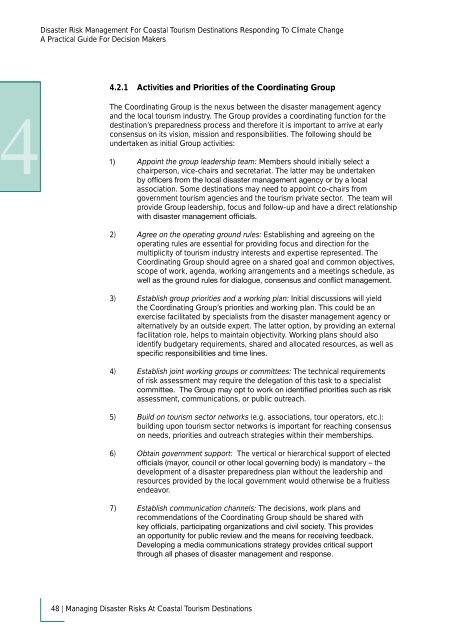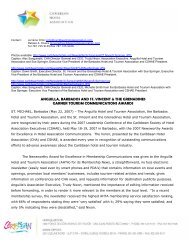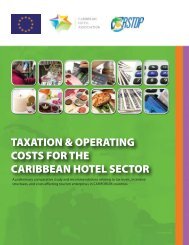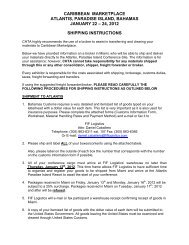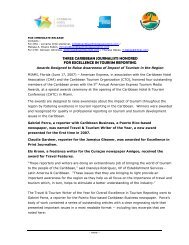Disaster Risk Management for Coastal Tourism - Caribbean Hotel ...
Disaster Risk Management for Coastal Tourism - Caribbean Hotel ...
Disaster Risk Management for Coastal Tourism - Caribbean Hotel ...
Create successful ePaper yourself
Turn your PDF publications into a flip-book with our unique Google optimized e-Paper software.
<strong>Disaster</strong> <strong>Risk</strong> <strong>Management</strong> For <strong>Coastal</strong> <strong>Tourism</strong> Destinations Responding To Climate Change<br />
A Practical Guide For Decision Makers<br />
4.2.1<br />
Activities and Priorities of the Coordinating Group<br />
The Coordinating Group is the nexus between the disaster management agency<br />
and the local tourism industry. The Group provides a coordinating function <strong>for</strong> the<br />
destination’s preparedness process and there<strong>for</strong>e it is important to arrive at early<br />
consensus on its vision, mission and responsibilities. The following should be<br />
undertaken as initial Group activities:<br />
Appoint the group leadership team: Members should initially select a<br />
chairperson, vice-chairs and secretariat. The latter may be undertaken<br />
<br />
association. Some destinations may need to appoint co-chairs from<br />
government tourism agencies and the tourism private sector. The team will<br />
provide Group leadership, focus and follow-up and have a direct relationship<br />
<br />
2) Agree on the operating ground rules: Establishing and agreeing on the<br />
operating rules are essential <strong>for</strong> providing focus and direction <strong>for</strong> the<br />
multiplicity of tourism industry interests and expertise represented. The<br />
Coordinating Group should agree on a shared goal and common objectives,<br />
scope of work, agenda, working arrangements and a meetings schedule, as<br />
<br />
3) Establish group priorities and a working plan: Initial discussions will yield<br />
the Coordinating Group’s priorities and working plan. This could be an<br />
exercise facilitated by specialists from the disaster management agency or<br />
alternatively by an outside expert. The latter option, by providing an external<br />
facilitation role, helps to maintain objectivity. Working plans should also<br />
identify budgetary requirements, shared and allocated resources, as well as<br />
<br />
4) Establish joint working groups or committees: The technical requirements<br />
of risk assessment may require the delegation of this task to a specialist<br />
<br />
assessment, communications, or public outreach.<br />
5) Build on tourism sector networks (e.g. associations, tour operators, etc.):<br />
building upon tourism sector networks is important <strong>for</strong> reaching consensus<br />
on needs, priorities and outreach strategies within their memberships.<br />
6) Obtain government support: The vertical or hierarchical support of elected<br />
<br />
development of a disaster preparedness plan without the leadership and<br />
resources provided by the local government would otherwise be a fruitless<br />
endeavor.<br />
7) Establish communication channels: The decisions, work plans and<br />
recommendations of the Coordinating Group should be shared with<br />
<br />
<br />
<br />
<br />
48 | Managing <strong>Disaster</strong> <strong>Risk</strong>s At <strong>Coastal</strong> <strong>Tourism</strong> Destinations


